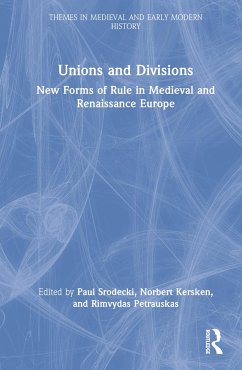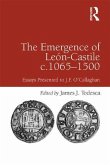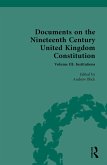Unions and Divisions
New Forms of Rule in Medieval and Renaissance Europe
Herausgeber: Srodecki, Paul; Petrauskas, Rimvydas; Kersken, Norbert
Unions and Divisions
New Forms of Rule in Medieval and Renaissance Europe
Herausgeber: Srodecki, Paul; Petrauskas, Rimvydas; Kersken, Norbert
- Gebundenes Buch
- Merkliste
- Auf die Merkliste
- Bewerten Bewerten
- Teilen
- Produkt teilen
- Produkterinnerung
- Produkterinnerung
Providing a comprehensive and engaging account of personal unions, composite monarchies and multiple rule in premodern Europe, Unions and Divisions. New Forms of Rule in Medieval and Renaissance Europe uses a comparative approach to examine the phenomena of the medieval and renaissance unions in a pan-European overview.
Andere Kunden interessierten sich auch für
![The Emergence of Le�n-Castile C.1065-1500 The Emergence of Le�n-Castile C.1065-1500]() The Emergence of Le�n-Castile C.1065-1500206,99 €
The Emergence of Le�n-Castile C.1065-1500206,99 €![Ireland, France, and the Atlantic in a Time of War Ireland, France, and the Atlantic in a Time of War]() Thomas M TruxesIreland, France, and the Atlantic in a Time of War206,99 €
Thomas M TruxesIreland, France, and the Atlantic in a Time of War206,99 €![Veteran MPs and Conservative Politics in the Aftermath of the Great War Veteran MPs and Conservative Politics in the Aftermath of the Great War]() Richard CarrVeteran MPs and Conservative Politics in the Aftermath of the Great War217,99 €
Richard CarrVeteran MPs and Conservative Politics in the Aftermath of the Great War217,99 €![Black Democracy Black Democracy]() H P DavisBlack Democracy183,99 €
H P DavisBlack Democracy183,99 €![The Soviet Way of Life The Soviet Way of Life]() Maurice LovellThe Soviet Way of Life137,99 €
Maurice LovellThe Soviet Way of Life137,99 €![Documents on the Nineteenth Century United Kingdom Constitution Documents on the Nineteenth Century United Kingdom Constitution]() Documents on the Nineteenth Century United Kingdom Constitution171,99 €
Documents on the Nineteenth Century United Kingdom Constitution171,99 €![Revolution and Reaction Revolution and Reaction]() Revolution and Reaction183,99 €
Revolution and Reaction183,99 €-
-
-
Providing a comprehensive and engaging account of personal unions, composite monarchies and multiple rule in premodern Europe, Unions and Divisions. New Forms of Rule in Medieval and Renaissance Europe uses a comparative approach to examine the phenomena of the medieval and renaissance unions in a pan-European overview.
Hinweis: Dieser Artikel kann nur an eine deutsche Lieferadresse ausgeliefert werden.
Hinweis: Dieser Artikel kann nur an eine deutsche Lieferadresse ausgeliefert werden.
Produktdetails
- Produktdetails
- Verlag: Taylor & Francis
- Seitenzahl: 366
- Erscheinungstermin: 25. November 2022
- Englisch
- Abmessung: 234mm x 156mm x 22mm
- Gewicht: 721g
- ISBN-13: 9781032057507
- ISBN-10: 1032057505
- Artikelnr.: 64105089
- Herstellerkennzeichnung
- Libri GmbH
- Europaallee 1
- 36244 Bad Hersfeld
- gpsr@libri.de
- Verlag: Taylor & Francis
- Seitenzahl: 366
- Erscheinungstermin: 25. November 2022
- Englisch
- Abmessung: 234mm x 156mm x 22mm
- Gewicht: 721g
- ISBN-13: 9781032057507
- ISBN-10: 1032057505
- Artikelnr.: 64105089
- Herstellerkennzeichnung
- Libri GmbH
- Europaallee 1
- 36244 Bad Hersfeld
- gpsr@libri.de
Paul Srodecki holds a Ph.D. from Gießen University, Germany, and has also been working as an Assistant Professor, Research Fellow and Lecturer in Medieval and Eastern European History at various other academic institutions, including the universities of Kiel, Germany, and Ostrava, Czechia. He has published several treatises on alterity and alienity discourses as well as historical deconstruction. Norbert Kersken was a teaching and research fellow at the Herder Institute for Historical Research on East-Central Europe in Marburg and at the University of Giessen, both in Germany, until 2021. He holds a Ph.D. from the University of Münster, Germany, with a dissertation on medieval national historiography. Rimvydas Petrauskas is professor of medieval history and (since 2020) rector of Vilnius University, Lithuania. His main research interests include the political and social histories of the grand duchy of Lithuania from the thirteenth to the sixteenth centuries as well as the image of the Middle Ages in modern society.
Preface PART I: CONCEPTUAL AND THEORETICAL FRAMEWORKS 1. Introduction: Medieval and Renaissance Personal Unions - Main Debates, New Approaches 2. Unions as a Structural Element: Preconditions, Intentions, and Realisations 3. Dynasties and Dynastic Rule between Elite Reproduction and State Building in Europe, 1300-1600 PART II: BETWEEN COERCION AND POLITICAL REASON 4. Dynastic Unions and the Development of Solid and Widespread Christian Polities in Iberia, 1100-1300 5. Angevin Empire: Between Dynastic Construct and Imperial Government 6. On the Genesis of the Polish-Lithuanian Union 7. For the Rescue of the Eastern Policy? The Union of the Grand Duchy of Lithuania with the King-dom of Poland and Relations with their Eastern Neighbours 8. Bishop, Administrator, Guardian: Albert of Hoya (
1473) and His Reign in Minden, Osnabrück and Hoya PART III: BETWEEN ASPIRATION AND REALITY 9. The Title rex Galiciae between Ambitions and Reality 10. The Union between Hungary and Croatia: Facts and Legends 11. The Lusatias in Personal Union with Brandenburg and Bohemia 12. The Foreign Policy of the Last P
emyslids: A First Attempt at Unifying Central Europe? 13. How Did the Grand Masters of the Teutonic Order Interpret their Dependence on the Polish Crown (1466-1497)? 14. An Autonomous Dependency? The Unstable Relationship between the Elites in Royal Prussia and the Polish Crown 1466-1569 15. Feoffment as a Tool in the Safeguarding of Power? Dithmarschen between Holsatian and Archi-episcopal Power Claims (1500-1559) PART IV: BETWEEN COINCIDENCE AND INTENTION 16. Wenceslaus II P
emyslid and Louis I of Hungary: Two Personal Unions in the History of the Polish Kingdom in the Fourteenth Century 17. Mary and Maximilian I - Burgundy and Habsburg: Rise of an Empire 18. Albert II of Habsburg's Composite Monarchy and its Significance for Central Europe 19. The Rulers of Poland-Lithuania and the Issue of Church Union from the Late Fourteenth to Early Sixteenth Centuries 20. The Unions between Sleswick, Holsatia and Denmark in the Fifteenth and Sixteenth Centuries and their Nordic Precursors PART V: BETWEEN DYNASTIC EXTENSION AND OVERSTRETCHING 21. The Union Wars within the Nordic Kalmar Union, 1448-1523 22. The Policies for and from the Dynastic Union: The Crowns of Castile and Aragon in the Fifteenth Century 23. Corona regni Bohemiae: An Idea of the Luxemburgers and Their Successors for the Integration of Central Europe 24. Towards 'the Danube Monarchy'? The Political Legacy of Emperor Sigismund and its Executors in the Fifteenth Century 25. Jagiellonian Attempts at Creating a Dynastic Great Power between the Baltic and the Black Seas and the Adriatic around 1500
1473) and His Reign in Minden, Osnabrück and Hoya PART III: BETWEEN ASPIRATION AND REALITY 9. The Title rex Galiciae between Ambitions and Reality 10. The Union between Hungary and Croatia: Facts and Legends 11. The Lusatias in Personal Union with Brandenburg and Bohemia 12. The Foreign Policy of the Last P
emyslids: A First Attempt at Unifying Central Europe? 13. How Did the Grand Masters of the Teutonic Order Interpret their Dependence on the Polish Crown (1466-1497)? 14. An Autonomous Dependency? The Unstable Relationship between the Elites in Royal Prussia and the Polish Crown 1466-1569 15. Feoffment as a Tool in the Safeguarding of Power? Dithmarschen between Holsatian and Archi-episcopal Power Claims (1500-1559) PART IV: BETWEEN COINCIDENCE AND INTENTION 16. Wenceslaus II P
emyslid and Louis I of Hungary: Two Personal Unions in the History of the Polish Kingdom in the Fourteenth Century 17. Mary and Maximilian I - Burgundy and Habsburg: Rise of an Empire 18. Albert II of Habsburg's Composite Monarchy and its Significance for Central Europe 19. The Rulers of Poland-Lithuania and the Issue of Church Union from the Late Fourteenth to Early Sixteenth Centuries 20. The Unions between Sleswick, Holsatia and Denmark in the Fifteenth and Sixteenth Centuries and their Nordic Precursors PART V: BETWEEN DYNASTIC EXTENSION AND OVERSTRETCHING 21. The Union Wars within the Nordic Kalmar Union, 1448-1523 22. The Policies for and from the Dynastic Union: The Crowns of Castile and Aragon in the Fifteenth Century 23. Corona regni Bohemiae: An Idea of the Luxemburgers and Their Successors for the Integration of Central Europe 24. Towards 'the Danube Monarchy'? The Political Legacy of Emperor Sigismund and its Executors in the Fifteenth Century 25. Jagiellonian Attempts at Creating a Dynastic Great Power between the Baltic and the Black Seas and the Adriatic around 1500
Preface PART I: CONCEPTUAL AND THEORETICAL FRAMEWORKS 1. Introduction: Medieval and Renaissance Personal Unions - Main Debates, New Approaches 2. Unions as a Structural Element: Preconditions, Intentions, and Realisations 3. Dynasties and Dynastic Rule between Elite Reproduction and State Building in Europe, 1300-1600 PART II: BETWEEN COERCION AND POLITICAL REASON 4. Dynastic Unions and the Development of Solid and Widespread Christian Polities in Iberia, 1100-1300 5. Angevin Empire: Between Dynastic Construct and Imperial Government 6. On the Genesis of the Polish-Lithuanian Union 7. For the Rescue of the Eastern Policy? The Union of the Grand Duchy of Lithuania with the King-dom of Poland and Relations with their Eastern Neighbours 8. Bishop, Administrator, Guardian: Albert of Hoya (
1473) and His Reign in Minden, Osnabrück and Hoya PART III: BETWEEN ASPIRATION AND REALITY 9. The Title rex Galiciae between Ambitions and Reality 10. The Union between Hungary and Croatia: Facts and Legends 11. The Lusatias in Personal Union with Brandenburg and Bohemia 12. The Foreign Policy of the Last P
emyslids: A First Attempt at Unifying Central Europe? 13. How Did the Grand Masters of the Teutonic Order Interpret their Dependence on the Polish Crown (1466-1497)? 14. An Autonomous Dependency? The Unstable Relationship between the Elites in Royal Prussia and the Polish Crown 1466-1569 15. Feoffment as a Tool in the Safeguarding of Power? Dithmarschen between Holsatian and Archi-episcopal Power Claims (1500-1559) PART IV: BETWEEN COINCIDENCE AND INTENTION 16. Wenceslaus II P
emyslid and Louis I of Hungary: Two Personal Unions in the History of the Polish Kingdom in the Fourteenth Century 17. Mary and Maximilian I - Burgundy and Habsburg: Rise of an Empire 18. Albert II of Habsburg's Composite Monarchy and its Significance for Central Europe 19. The Rulers of Poland-Lithuania and the Issue of Church Union from the Late Fourteenth to Early Sixteenth Centuries 20. The Unions between Sleswick, Holsatia and Denmark in the Fifteenth and Sixteenth Centuries and their Nordic Precursors PART V: BETWEEN DYNASTIC EXTENSION AND OVERSTRETCHING 21. The Union Wars within the Nordic Kalmar Union, 1448-1523 22. The Policies for and from the Dynastic Union: The Crowns of Castile and Aragon in the Fifteenth Century 23. Corona regni Bohemiae: An Idea of the Luxemburgers and Their Successors for the Integration of Central Europe 24. Towards 'the Danube Monarchy'? The Political Legacy of Emperor Sigismund and its Executors in the Fifteenth Century 25. Jagiellonian Attempts at Creating a Dynastic Great Power between the Baltic and the Black Seas and the Adriatic around 1500
1473) and His Reign in Minden, Osnabrück and Hoya PART III: BETWEEN ASPIRATION AND REALITY 9. The Title rex Galiciae between Ambitions and Reality 10. The Union between Hungary and Croatia: Facts and Legends 11. The Lusatias in Personal Union with Brandenburg and Bohemia 12. The Foreign Policy of the Last P
emyslids: A First Attempt at Unifying Central Europe? 13. How Did the Grand Masters of the Teutonic Order Interpret their Dependence on the Polish Crown (1466-1497)? 14. An Autonomous Dependency? The Unstable Relationship between the Elites in Royal Prussia and the Polish Crown 1466-1569 15. Feoffment as a Tool in the Safeguarding of Power? Dithmarschen between Holsatian and Archi-episcopal Power Claims (1500-1559) PART IV: BETWEEN COINCIDENCE AND INTENTION 16. Wenceslaus II P
emyslid and Louis I of Hungary: Two Personal Unions in the History of the Polish Kingdom in the Fourteenth Century 17. Mary and Maximilian I - Burgundy and Habsburg: Rise of an Empire 18. Albert II of Habsburg's Composite Monarchy and its Significance for Central Europe 19. The Rulers of Poland-Lithuania and the Issue of Church Union from the Late Fourteenth to Early Sixteenth Centuries 20. The Unions between Sleswick, Holsatia and Denmark in the Fifteenth and Sixteenth Centuries and their Nordic Precursors PART V: BETWEEN DYNASTIC EXTENSION AND OVERSTRETCHING 21. The Union Wars within the Nordic Kalmar Union, 1448-1523 22. The Policies for and from the Dynastic Union: The Crowns of Castile and Aragon in the Fifteenth Century 23. Corona regni Bohemiae: An Idea of the Luxemburgers and Their Successors for the Integration of Central Europe 24. Towards 'the Danube Monarchy'? The Political Legacy of Emperor Sigismund and its Executors in the Fifteenth Century 25. Jagiellonian Attempts at Creating a Dynastic Great Power between the Baltic and the Black Seas and the Adriatic around 1500








